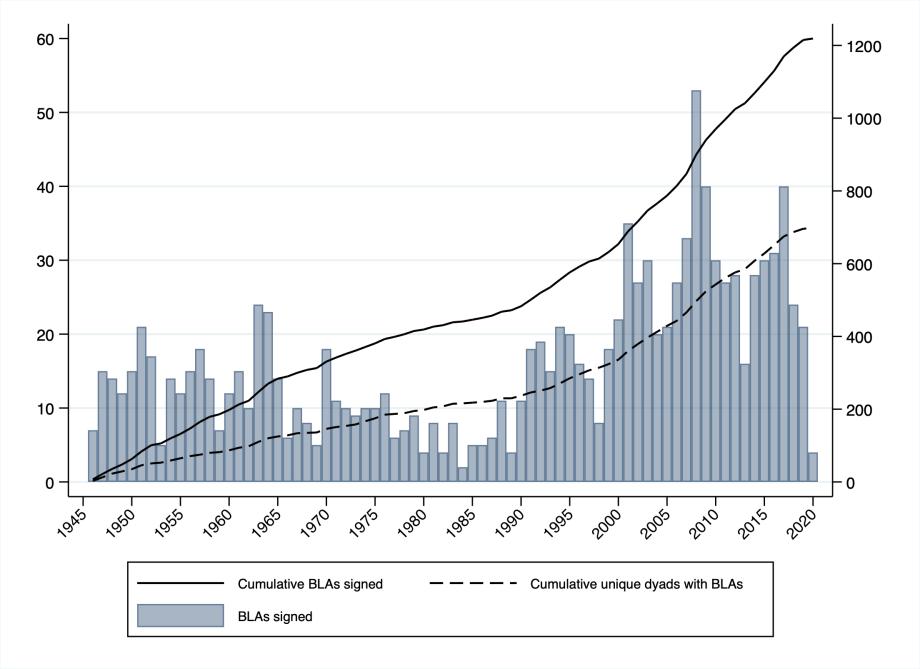Bilateral Labor Agreements Dataset

Background
Pairs of countries have signed hundreds of Bilateral Labor Agreements (BLAs) to regulate the flow of migrants between countries. But unlike Bilateral Investment Treaties or Preferential Trade Agreements, BLAs have received little attention from social scientists or legal scholars. This is, in large part, because information on the existence of BLAs has been hard to come by. This website documents our ongoing project to make information on BLAs publicly available.
In the first stage of this project, Adam Chilton and Eric Posner researched why countries sign BLAs. For that research, Adam and Eric worked with Bartek Woda and a team of research assistants and librarians at the University of Chicago to document BLAs signed between 1945 and 2015. In 2017, they publicly released a dataset of 582 Bilateral Labor Agreements they found as part of that research. Their findings were later published in an article in the Journal of Legal Studies.
In the second stage of this project, Adam Chilton and Bartek Woda renewed their efforts to find BLAs and learn more about their contents. They directly built on the earlier research with Eric Posner, the related research of UCLA political science professor Margret Peters, and Adam and Bartek’s ongoing research on the effects of BLAs. This stage of the project produced three new resources: (1) a dataset documenting the formation of over 1,200 BLAs; (2) a corpus including the texts of over 800 BLAs; and (3) a dataset coding whether over 500 BLAs mention twenty topics that the ILO has identified as best practices for these agreements. These resources were released as part of a conference on Bilateral Labor Agreements organized by Hila Shimar, and Tamar Megiddo for the Trafflab at Tel Aviv University and special issue of Theoretical Inquires in Law guest edited by Adam, Hila, and Tamar.
Datasets
The Bilateral Labor Agreements Dataset currently includes three separate resources.
Dataset #1 - BLA Formation
The first resource is a dataset on the formation of BLAs. For this dataset, the unit of observation is a treaty. Treaties were obtained from a variety of sources over a number of years. The current version of the dataset includes information on 1,222 BLAs.
Dataset #2 - BLA Corpus
The second resource is a corpus of the text of the BLAs. The current version of this corpus includes copies of 819 BLAs. The corpus also includes files documenting the existence of 248 additional BLAs for which we were not able to obtain a copy of the agreement.
Dataset #3 - BLA Coding
The third resource is a dataset coding the contents of BLAs. For this coding, we began with best practice guides developed by the International Labour Organization, and then coded each agreement for whether they contained each of the 20 elements identified as key features of BLAs. The current version of the dataset codes the contents of 571 BLAs.
Support
This research was been financially supported by a number of organizations affiliated with the University of Chicago: the University of Chicago Law School’s Policy Initiative Program supported by the Kanter Family Foundation; the Coase-Sandor Center for Law and Economics; the Becker-Friedman Institute for Economics; and the Pearson Institute for the Study and Resolution of Global Conflicts.
Acknowledgements
We would like to thank all of the researchers that have contributed to this project, including: Isabelle Argueta, Rupan Bharanidaran, Maggie Bushell, Rebecca Chong, Natalie Ciresi, Christy Crouse, Joaquin Gonzalez, Kelly Gregg, Kathrine Gutierrez, Ian Howard, Yang Li, James Marmaduke, Matt Maxson, Adrian Moreno, Amanda Pickens, Emilia Porubcin, Brad Posdal, Rafeh Qureshi, Angela Remus, Sam Renner, Nick Smith, Bonnie St. Charles, Catherine Steubing, Amber Stewart, and Sarah Wang. Special thanks are due to thank Lyonette Louis-Jacques and Vera Shikhelman.
Citation
We ask all researchers using these datasets to cite two papers:
- Adam Chilton and Bartosz Woda. 2022. “The Expanding Universe of Bilateral Labor Agreements.” Theoretical Inquires in Law 23(2): 1-64 (available at the journal website and as a working paper on SSRN).
- Adam S. Chilton and Eric A. Posner. 2018. “Why Countries Sign Bilateral Labor Agreements.” Journal of Legal Studies 47(S1): 45-88 (available at the journal website and as a working paper on SSRN).
Since the second version of the datasets also builds on work by Margaret Peters, please also considering citing:
- Margaret E. Peters. 2019. “Immigration and International Law.” International Studies Quarterly 63(2): 281-295 (available at the journal website and as a working paper on SSRN).
Contact
If you have any questions, comments, or corrections, please contact Adam Chilton.
Download
The Bilateral Labor Agreements Dataset is available for download at the dataverse.